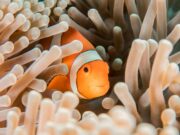The rebrand comes as Green Fins' are urgently ramping up their work due to climate change impacts. The initiative continues to grow and adapt from a simple code of conduct to an ever-expanding sustainable network. To date, the initiative has spread to 14 countries and connected with thousands of divers, dive professionals and operators worldwide.
The Wildlife Trust of South & West Wales gives useful advice on what to do if you see a whale, dolphin or porpoise on a beach.
If you find a live whale, dolphin...
Restoring whale numbers would mean more iron in the water from their poo, which would mean more phytoplankton, and more carbon dioxide taken up from the atmosphere. Whales once contributed to as much carbon removal as forests of entire continents.
A shy fish, the leopard-spotted goby lives in cracks on steep walls and caves. Shipwrecks are also a favourite habitat. You find them in the shallows and down to 40 m. It tends to face its crevice...
The most common clownfish in the Red Sea, hence its name. But it doesn't just live in the Red Sea. You will also find it in the Gulf of Aden and in the Chagos Islands in the...
Thailand has banned several sunscreen products from the country’s national marine parks. These contain chemical compounds proven to be harmful to coral reefs
People ignoring the ban can be fined 100,000 baht - nearly $3000...
Although some have argued that climate change is so overwhelming that conserving coral reefs on a local scale is futile, study finds local actions magnify the effects of climate-driven heat waves. Local action to conserve coral reefs can help reefs withstand the effects of climate change.
New technology which can listen to, and identify, right whales could help protect these extremely endangered animals. Finding the animals before they get close to ships can both protect animals and avoid costly shutdowns of offshore operations.
The Coral Triangle and Pacific Ocean host some of the world’s most biodiverse dive destinations, where you can encounter over 3000 fish species and 70% of all known coral species. Offering unparalleled reef and wreck diving, marine...
1. They are the most poisonous fish in the sea
The Puffer is harmless, unless eaten. The liver, intestines, gonads and skin are highly poisonous and cause death in around 60% of people...





























